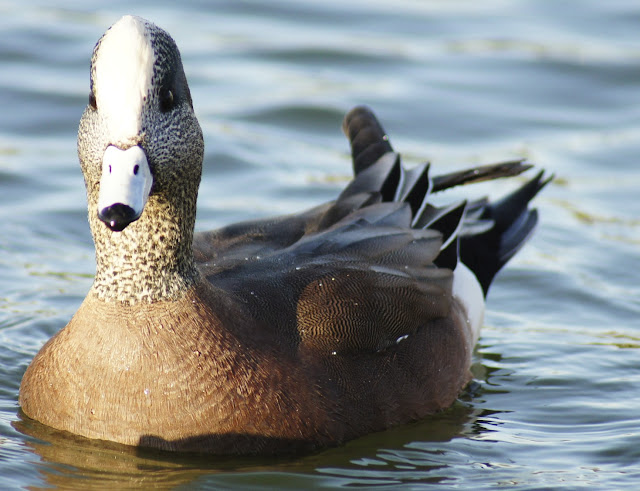This solitary American Wigeon was among the gang of dabbling ducks at Papago Park this Saturday. This is the first Wigeon I've seen since leaving Texas, and he presented an interesting and difficult photo opportunity. This male is in his 'eclipse', or non-breeding plumage (he'll develop a nice green and white stripe along his head in the Spring), and like all Wigeons he has what I'll call a sunken eye. The Wigeon head is unusually streaked/mottled, and while the eye is a nice almond brown, even red at certain angles, I discovered it is pretty difficult to get the eye to stand out from the rest of the head.
The Wigeon mingled with the Mallards and the Coots at the Papago ponds. There wasn't another Wigeon in sight, which is a little bit unusual. I seldom see single ducks, excluding Gary over at Grenada Park, but he seemed pretty comfortable with himself.
Except at the right angles, the almond eye gets caught in the contour shadow of the Wigeon's head. Usually with birds that have distinct contrasts, you can enhance or dim certain areas with the exposure compensation on the camera. I couldn't draw the eye out on my own, but had to rather wait for the Wigeon to turn its head favorably. However, the shadow over the eye does show the interesting cranial shape of the Wigeon. The upper head and jawline bulges in a kind of hourglass figure. Pretty neat!
I like this 'eclipse' plumage a lot. It seems very autumn appropriate. The male's eclipse plumage is actually pretty similar to the female's normal coloration, but the richer chestnut sides set this masculine specimen apart. He's a very well put together duck--sturdy looking, with his feathers nicely composed. Just add an iridescent green cap above the eye, with a white streak right over the top, and he'll be making the lady wigeon hearts flutter come Spring time.
I saw this male on 11/04/2011. Hopefully he'll hang around and I can get some closer images.


















